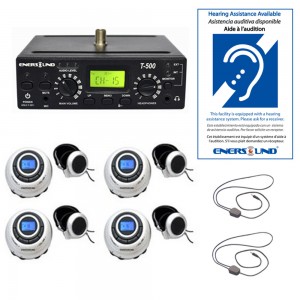Are You Getting the Full Story? Hearing Impairment and Assistive Listening Solutions in Educational and Corporate Environments
Every day we face experiences without even taking a few seconds to think about the abilities required to perform successfully in every one of them. But if those abilities are missing or if they are not completely functional, I´m almost sure that we wouldn´t spend another day without thinking about those things we used to take for granted.
Hearing is one of those abilities.
In 1990, Congress passed a key piece of legislation called the “Americans with Disabilities Act” (ADA), and it was finally revised in 2010. The law prohibits discrimination and ensures equal opportunity for persons with disabilities in employment, State and local government services, public accommodations, commercial facilities, and transportation.
And why is this important?
Because Title III of the Americans with Disabilities Act (ADA), relating to nondiscrimination on the basis of disability by public accommodations and in commercial facilities, enforces to meet a minimum of requirements for people with disabilities. Assistive listening is one of those requirements, and we can appreciate how important is to overcome hearing loss for those who suffer from it.
When hearing loss manifests as an everyday problem, not only you lose essential capabilities to develop certain activities properly, but also there is a great deal of feeling excluded and segregated from several places and events. And this is one the most problematic side effects of hearing impairment. Amanda Nichols[1] clearly states this: “hearing loss can lead to social isolation, stress, and functional problems, such as impaired balance and others.”
“Hearing loss can be dealt with effectively to improve a resident’s quality of life. Hearing loss is the third most common chronic condition found in the elderly population, following hypertension and arthritis”, says Nichols. This point, added to the fact that one in eight people in the United States (13 percent, or 30 million) aged 12 years or older has hearing loss in both ears, based on standard hearing examinations[2], makes this issue a major topic to be considered by institutions and people in charge of assuring a pleasant and adequate environment for everyone.
FM listening systems have been used in multiple settings for hearing-impaired children for over 25 years. These can best be conceptualized as FM radios, with a transmitter sending a wireless signal to an FM receiver worn by the listener. Our Enersound 4-Person Assistive Listening System with Neckloops and ADA Plaque is a multichannel solution (in the 72-76 MHz band) to meet the needs of the Americans with Disabilities Act (ADA) standards for accessible design, useful for venues up to 100 seats.
In addition to ensuring that public facilities are compliant; the system can also be used to improve comprehension by people who have difficulty hearing or understanding speech in various settings including meeting rooms, houses of worship, movie theatres, schools, public hearing rooms, and more. The audio is sent wirelessly straight to their ears, avoiding the degrading effects of noise and distance on speech intelligibility.

PRIDE Industries, one of our clients and one of the nation’s largest nonprofit employers of people with disabilities, is very satisfied with Enersound equipment. They provide the support, training and opportunity necessary to help people with disabilities find meaningful employment. Some of their employees have hearing disabilities, and the assistive listening system was indeed a great difference for them and for the people working there.
A staff member at PRIDE Industries attested that they have over 40 people with hearing impairments at their workplace, and as their mission is to create jobs for people with disabilities, getting an Enersound system with neckloops and wireless receivers was a big change for them, helping to improve communication and everyday work.
Assistive Listening solutions may represent a big change for those in need, and we feel comforted when we are able to make a difference in people’s lives and their quality of living through innovation.
[1] AMANDA D. NICHOLS Hearing Loss: Perceptions and Solutions. http://www.ltlmagazine.com/article/hearing-loss-perceptions-and-solutions
[2] Lin FR, Niparko JK, Ferrucci L. Hearing loss prevalence in the United States. [Letter] Arch Intern Med. 2011 Nov 14; 171(20): 1851-1852.

